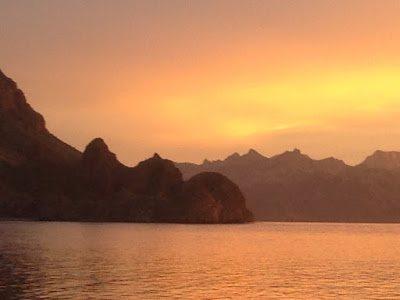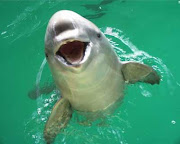DAY SIX
[Feb. 7, 2015
A quiet, calm night, with brilliant white stars in a black cloudless sky. Never have I seen so many stars! And a quiet, calm morning, the early moon like a soft bubble in the sky. With the low angle of the morning sun, the hills glow neon red. We make an early start today, hoping to make the longest passage while the weather is so calm. There is one stop along the way – tiny Isla Coyote – a mound of brown rock with a cliff face to the south, gently sloping down to the small shore, and a surprising cluster of bleached square buildings tucked and layered into the hillside, reminding me of a classic Mediterranean coastal village. There is what looks like a Spanish mission chapel nestled at the very top of the hill, classic twin square towers straddling a small arched entry, maybe a comfort for this quaint, isolated fishing village.
I can make out three long sheds along the beach, with
thatched roofs, and I can see two white dories pulled up on the rocky shore,
which is also dotted with colorful spots of yellow and orange. I realize these are the fishermen, in their
bright, suspended, rubber trousers. They
are pulling in the nets from the boats, gathering in a plentiful morning’s
catch, and sorting fish into a collection of large buckets and tubs. This accounts for the abundance of raucous
sea gulls noisily covering that end of the island.
This little fishing village is named El Pardito – “little
brown island” – and is currently inhabited by perhaps twenty individuals. Alberto and Rosalita moved their young family
to this rock in 1923, getting away from the noise and bugginess of LaPaz, to
this quiet spot where they could enjoy life to themselves and the soft sea
breezes.
They subsist on what comes from the sea, plus three small pineapple plants struggling to survive in a small plot of dirt. They raised their family of five children here, built homes into the hillsides, including a small schoolhouse, and the chapel, when their sixth child died in infancy because they couldn’t get to a doctor. Other fishermen have come and stayed for a time, some of the children moved back to the mainland, and the schoolhouse now stands empty.
Those still living here know that they may be the final generation, but it seems such a tranquil place, and a kind and happy way to live, that as long as fish fill the Sea of Cortez, this rock may stay inhabited. There are many such villages along the shore, but this was the only island village we saw.
They subsist on what comes from the sea, plus three small pineapple plants struggling to survive in a small plot of dirt. They raised their family of five children here, built homes into the hillsides, including a small schoolhouse, and the chapel, when their sixth child died in infancy because they couldn’t get to a doctor. Other fishermen have come and stayed for a time, some of the children moved back to the mainland, and the schoolhouse now stands empty.
Those still living here know that they may be the final generation, but it seems such a tranquil place, and a kind and happy way to live, that as long as fish fill the Sea of Cortez, this rock may stay inhabited. There are many such villages along the shore, but this was the only island village we saw.
Bill drops anchor here and soon a skiff pulls away from the
island and heads our way, loaded with over a dozen 8-gallon blue plastic drums. “Me
llamo Pablo,” our guest grins up at me as I stand at the rail of the
Westward. He is a short, very
brown-skinned man with friendly dark eyes and a wide-brimmed straw hat. He is barefoot and his gray polyester pants
are rolled up to just below the knee. He
nimbly steps from thwart to thwart of his small white boat, rocking in the
waves, while he passes up a rope to be tied off. “Mucho
gusto, soy Carolina,” I manage in return. “Tengo mucho agua por usted,” says Bill, “Gusto
usted agua dulce?” “We have lots of fresh water for you. Would you like a coke while we fill the jugs?”
usted agua dulce?” “We have lots of fresh water for you. Would you like a coke while we fill the jugs?”
One of the reasons these islands are not populated with
humans is the lack of fresh water. There
just is no source. This little fishing
village relies on water skiffed in from the mainland. Randy, as engineer, has been making water all morning. The ship’s supply of fresh water comes from
an on-board desalinization process, making pure water from the salt sea through
reverse osmosis. With a 1000-gallon
water tank, we have plenty to share.
This has become a regular stop on the Westward’s north/south passage,
bringing fresh water to this tiny village in exchange for fresh fish. The guests, too, are invited to come ashore
and visit this remarkable place and see their fishing operation. A daughter, Cordelia, has beautiful jewelry
for sale on her shady thatched and tiled terrace; she makes these herself from
local shells and beads.
With his water drums filled to the brim, Pablo offers many muchos gracias, and returns with a sack
of fresh trigger-fish from the morning’s catch.
We toss him several coca-colas in return, and we will have Tracie’s
amazing ceviche tacos for supper
tonight. We’ll see Pablo again next
week, on our trip back south.
Once underway, ahead, off the bow, I see a fin cut the water
and disappear. Then again, heading
straight toward the boat. Soon, two
bottlenose dolphin are swimming at the bow, one on each side. I can look straight down into the deep green
water and see clearly their sleek gray bodies – quite big! – purely enjoying
the ride. Each of them in turn roll to
the side as they go, and look right up at me with a bright round eye. Amazing experience, out in the wild, making
eye contact with a dolphin swimming intentionally alongside, there under the
clear green water.
After a long day of progress north in open water – though it
seemed to me we spent as much time moving up, and then down again, as we did
actually moving forward – we tucked in for the night behind Punto Marcial
(Marcial Point), in Bahia Berrendo on the peninsula. This seems a much wilder place than the
island bays, as high, jagged cliffs come down from the interior mountains to
meet the sea.
I see a long, low cave at low tide,right at the water's edge. A large, white-topped boulder looks like it has just been rolled away from the entrance. Interesting rock formation, I thought, half quartz -- that's odd. Then I saw the pelicans. And this, apparently, was their favorite roost: ah, pelican guano. Many, many pelicans. Resting, rafting, floating on the wind like a tiny platoon of hang gliders. Until one suddenly stops flying, and drops out of the sky - dive bombs kerplop! --into the water with a big splash -- and then lifts off again, joining the others in the aerial survey. A full pouch of supper, no doubt.
This bay is wilder, cut into the mountains, and it is a shallower bay, too, protected from the sea by only a slight jut of land. Most of the deeper inlets are surrounded on three sides. This protected exposure makes for a gentle roll all night long, like sleeping in a constantly rocking hammock.
This bay is wilder, cut into the mountains, and it is a shallower bay, too, protected from the sea by only a slight jut of land. Most of the deeper inlets are surrounded on three sides. This protected exposure makes for a gentle roll all night long, like sleeping in a constantly rocking hammock.
















No comments:
Post a Comment